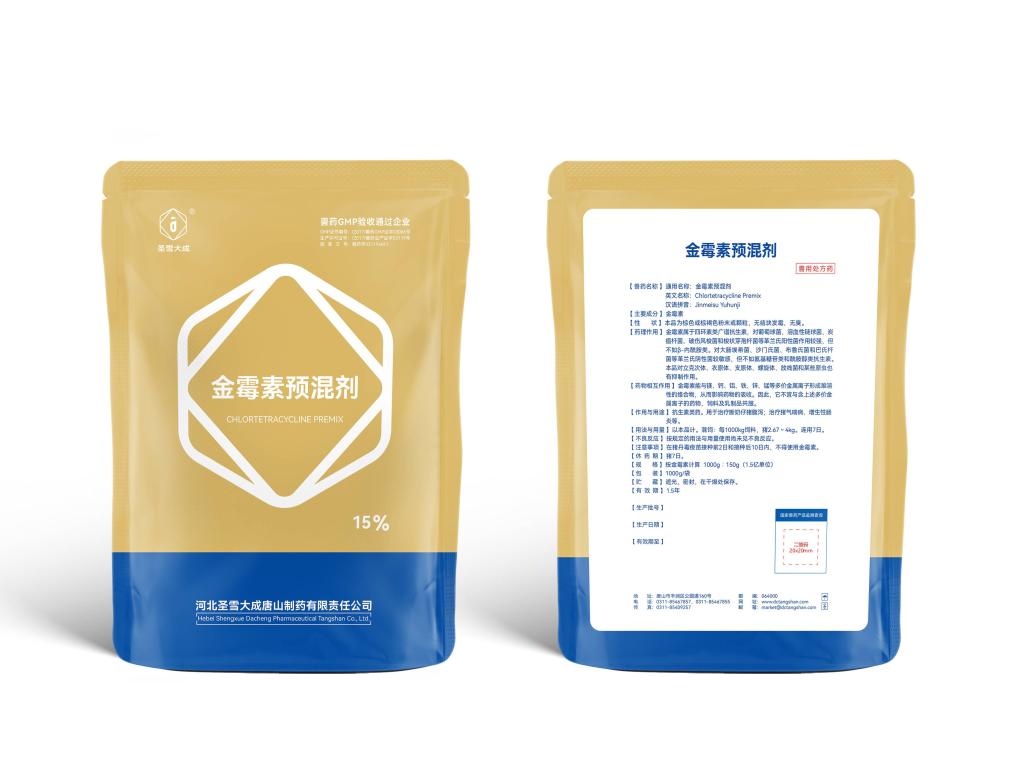Tel:+8618231198596

News
 CONTACT
CONTACT
 CONTACT
CONTACT
- Linkman:Linda Yao
- Tel: +8618231198596
- Email:linda.yao@dcpharma.cn
- Linkman:CHARLES.WANG
- Department:Overseas
- Tel: 0086 0311-85537378 0086 0311-85539701
News
Harnessing innovation to improve the formulation and delivery of Chlortetracycline Premix.
TIME:2024-06-03
Current Challenges and Limitations:
Antimicrobial Resistance (AMR): The widespread use of Chlortetracycline premix in animal agriculture has been associated with the emergence and spread of antimicrobial resistance among bacterial pathogens. The development of resistance compromises the effectiveness of Chlortetracycline and other antibiotics, posing risks to human and animal health.
Environmental Impact: Chlortetracycline residues from animal waste and agricultural runoff can contaminate soil, water, and ecosystems, leading to environmental degradation and potential risks to aquatic organisms, wildlife, and human populations. Minimizing environmental impact is essential for sustainable agriculture and ecosystem health.
Regulatory Compliance: Compliance with regulatory standards for Chlortetracycline use, including maximum residue limits (MRLs) in animal products, withdrawal periods, and labeling requirements, presents challenges for producers, veterinarians, and pharmaceutical manufacturers. Adherence to regulatory requirements is essential for market access and public health protection.
Innovative Approaches to Formulation and Delivery:
Nanoencapsulation: Nanoencapsulation technologies can be employed to encapsulate Chlortetracycline molecules within nano-sized particles, enhancing their stability, bioavailability, and targeted delivery. Nanoencapsulation protects Chlortetracycline from degradation in the gastrointestinal tract, allowing for controlled release and prolonged efficacy.
Microbial Delivery Systems: Probiotics, prebiotics, and other microbial delivery systems can be used as carriers for Chlortetracycline, facilitating targeted delivery to the gastrointestinal tract and promoting selective antimicrobial activity against pathogenic bacteria while preserving beneficial microbial communities.
Phytogenic Formulations: Incorporating phytogenic compounds, such as essential oils, flavonoids, and phenolic compounds, into Chlortetracycline premix formulations can enhance antimicrobial efficacy, reduce microbial resistance, and mitigate adverse effects on gut health. Phytogenic formulations offer natural alternatives to conventional antibiotics, promoting sustainable animal production practices.
Coated Granules and Pellets: Coating Chlortetracycline granules or pellets with protective layers, such as polymers or lipids, can improve stability, solubility, and release kinetics, ensuring uniform distribution and prolonged activity in the gastrointestinal tract. Coated formulations minimize dustiness, improve handling characteristics, and enhance palatability for livestock consumption.
Smart Delivery Systems: Smart delivery systems, such as pH-sensitive or stimuli-responsive nanoparticles, can modulate drug release in response to specific physiological conditions or environmental stimuli within the gastrointestinal tract. Smart formulations optimize Chlortetracycline delivery, minimizing off-target effects and enhancing therapeutic efficacy.
Benefits of Innovative Formulation and Delivery:
Enhanced Efficacy: Innovative formulation and delivery technologies improve the efficacy of Chlortetracycline premix by enhancing drug stability, bioavailability, and targeted delivery to the site of action. Enhanced efficacy reduces the required dosage, minimizes the development of antimicrobial resistance, and improves clinical outcomes in treated animals.
Reduced Environmental Impact: Innovative formulations and delivery systems minimize environmental contamination by reducing the release of Chlortetracycline residues into soil, water, and ecosystems. Controlled release formulations and targeted delivery mechanisms minimize off-target effects, ensuring maximum therapeutic benefit with minimal environmental impact.
Improved Safety Profile: Advanced formulation technologies improve the safety profile of Chlortetracycline premix by reducing the risk of adverse effects, such as gastrointestinal irritation, microbial dysbiosis, and allergic reactions. Controlled release formulations and encapsulation techniques optimize drug delivery, minimizing systemic exposure and off-target effects.
Regulatory Compliance: Innovative formulation and delivery technologies facilitate regulatory compliance by ensuring accurate dosing, precise administration, and adherence to withdrawal periods and labeling requirements. Compliance with regulatory standards promotes market acceptance, consumer confidence, and public health protection.
Challenges and Considerations:
Cost and Scalability: The development and implementation of innovative formulation and delivery technologies for Chlortetracycline premix may entail higher costs and technical challenges compared to conventional formulations. Cost-effective manufacturing processes and scalable production methods are needed to ensure affordability and accessibility.
Safety and Toxicity: Safety evaluation and risk assessment are essential considerations in the development of innovative Chlortetracycline formulations and delivery systems. Comprehensive toxicity studies, pharmacokinetic profiling, and environmental risk assessments are needed to ensure product safety and regulatory approval.
Consumer Acceptance: Consumer perception and acceptance of innovative Chlortetracycline formulations may vary depending on factors such as perceived safety, efficacy, and sustainability. Transparent communication, education, and engagement with stakeholders are essential for building trust and confidence in new technologies.
Future Directions and Opportunities:
Research and Development: Continued investment in research and development is needed to advance innovative formulation and delivery technologies for Chlortetracycline premix. Collaborative efforts between academia, industry, and government agencies can drive innovation and accelerate the translation of research findings into practical applications.
Regulatory Harmonization: Harmonization of regulatory standards and guidelines for the evaluation and approval of innovative Chlortetracycline formulations and delivery systems is critical for facilitating market access and international trade. Regulatory agencies play a key role in promoting innovation while ensuring product safety and efficacy.
Education and Training: Education and training programs for veterinarians, producers, and industry stakeholders are essential for promoting awareness, adoption, and responsible use of innovative Chlortetracycline formulations and delivery technologies. Training initiatives can empower stakeholders to make informed decisions and implement best practices in animal health management.
Sustainable Agriculture: Integration of innovative Chlortetracycline formulations and delivery systems into sustainable agriculture practices can contribute to the development of resilient, efficient, and environmentally friendly livestock production systems. Sustainable agriculture approaches prioritize animal welfare, environmental stewardship, and public health, aligning with global sustainability goals.
Conclusion:
Innovative formulation and delivery technologies offer promising opportunities to improve the efficacy, safety, and sustainability of Chlortetracycline premix in animal agriculture. By harnessing innovation, stakeholders can address current challenges and limitations associated with Chlortetracycline use, while advancing animal health, environmental stewardship, and regulatory compliance. Collaborative efforts, investment in research and development, and regulatory support are essential for realizing the full potential of innovative Chlortetracycline formulations and delivery systems in addressing the evolving needs of animal agriculture.
- Tel:+8618231198596
- Whatsapp:18231198596
- Chat With Skype







